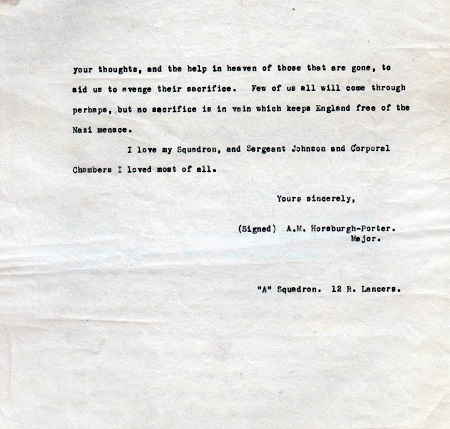Letter of condolence from Major Horsburgh-Porter of 'A' Squadron, the 12th Queen's Royal Lancers, to Mrs Johnson dated 8th June, 1940. It concerns the death of her husband while on active service in France.


The soldier concerned was Sergeant Ronald Johnson who was killed on the 22nd May 1940, aged 25. From the letter it appears that he was killed by a strafing Messerschmitt 109 while trying to bring his armoured car's Bren gun into action; Major Horsburgh-Porter was wounded in the hand. The incident seems to have taken place a few miles north of Arras in northern France, probably in the act of covering the British retreat from the town. He was buried with two other members of the regiment, killed on the same day, in L'Abbe Communal Cemetery. Corporal Howard Chambers, Sgt Johnson's best friend, is also referenced in the letter, having been killed two days before. He is buried in the churchyard at the tiny French hamlet of Béthonsart.
The regiment had arrived in France in October, 1939 with 35 Morris CS9 armoured cars. The intention was to use them in an armed reconnaissance role. They were the first BEF troops to enter Belgium on May 10th 1940 and first clashed with German panzer troops on the 12th May. They were ordered to cover the British retreat from the 'Dyle Line' and with their engineer company, proceeded to demolish numerous bridges in Belgium to slow the German advance. Even in these early days, the shortcomings of their lightly armoured vehicles when faced with tanks, or infantry in built up areas, became apparent.

Following the German breakthrough at Sedan and with the rapidly advancing Panzer columns threatening the rear of the BEF, the regiment was ordered south to the French town of Arras. Their mission was to help halt the German attack and cover the retreat of British garrison and depot troops from the town. Successful attacks were made on German motorcycle troops and a heavy artillery column. However, as enemy armoured units closed in, the regiment was forced into numerous holding actions and demolishing bridges to delay the Germans. Back in Belgium, a further crisis emerged as it became apparent that the Belgian Army was on the verge of capitulation. The remnants of 12th Royal Lancers were rushed northwards to Ypres, where they successfully held the town against German attack. They retreated to Dunkirk on the 29th May, blowing up the bridges across the River Yser and destroying all of their vehicles on the way. They were finally evacuated from the beaches at Dunkirk on the 31st May, 1940.


The soldier concerned was Sergeant Ronald Johnson who was killed on the 22nd May 1940, aged 25. From the letter it appears that he was killed by a strafing Messerschmitt 109 while trying to bring his armoured car's Bren gun into action; Major Horsburgh-Porter was wounded in the hand. The incident seems to have taken place a few miles north of Arras in northern France, probably in the act of covering the British retreat from the town. He was buried with two other members of the regiment, killed on the same day, in L'Abbe Communal Cemetery. Corporal Howard Chambers, Sgt Johnson's best friend, is also referenced in the letter, having been killed two days before. He is buried in the churchyard at the tiny French hamlet of Béthonsart.
The regiment had arrived in France in October, 1939 with 35 Morris CS9 armoured cars. The intention was to use them in an armed reconnaissance role. They were the first BEF troops to enter Belgium on May 10th 1940 and first clashed with German panzer troops on the 12th May. They were ordered to cover the British retreat from the 'Dyle Line' and with their engineer company, proceeded to demolish numerous bridges in Belgium to slow the German advance. Even in these early days, the shortcomings of their lightly armoured vehicles when faced with tanks, or infantry in built up areas, became apparent.

Following the German breakthrough at Sedan and with the rapidly advancing Panzer columns threatening the rear of the BEF, the regiment was ordered south to the French town of Arras. Their mission was to help halt the German attack and cover the retreat of British garrison and depot troops from the town. Successful attacks were made on German motorcycle troops and a heavy artillery column. However, as enemy armoured units closed in, the regiment was forced into numerous holding actions and demolishing bridges to delay the Germans. Back in Belgium, a further crisis emerged as it became apparent that the Belgian Army was on the verge of capitulation. The remnants of 12th Royal Lancers were rushed northwards to Ypres, where they successfully held the town against German attack. They retreated to Dunkirk on the 29th May, blowing up the bridges across the River Yser and destroying all of their vehicles on the way. They were finally evacuated from the beaches at Dunkirk on the 31st May, 1940.
